A new generation of fire extinguishers, resembling a fat flare in appearance, promise to solve most of the problems of standard fire extinguishers.
The biggest problem with traditional fire extinguishers is extinguishing rate. The typical 5BC extinguisher is often spent in as little as 10 seconds. It’s easy for an inexperienced user to deplete one before the fire is out. Likewise, the chemical itself, most commonly mono-ammonium phosphate, is highly corrosive to electronics. HFC 227 (which replaced Halon) and C02 extinguishers are safe around electronics but are expensive and have limitations of their own.
The new fire extinguishers are called pyrotechnically generated aerosol fire suppressants (or PGAs). They work by breaking the chain reaction that sustains a fire by chemically neutralizing the fire with a cloud of potassium particles.
We were all schooled on the fire triangle: heat, fuel, and oxygen. Remove any leg and the fire dies. Water cools by evaporation. C02 suffocates. Dry chemical removes fuel by coating it with ammonium phosphate particles. Since then, fire extinguishing theory has evolved into a fire tetrahedron, adding chain reaction to the group.
THE POSITIVES

- Longer Discharge Time. 12 seconds for the tiny Maus and 50 seconds for the still more compact Element.
- Less Residue. Reduced corrosion damage to electronics and minimal clean-up.
- No Reignition. So long as the cloud remains in place, relighting is prevented.
- Compact. Less than 1/3 the volume of 10BC dry chemical extinguisher.
- Rugged. Less prone to physical damage. No handle or gauge.
- Inexpensive. 1/3 to 1/5 the price of clean agent extinguishers (carbon dioxide or HFC-227).
THE NEGATIVES
- Not UL listed. Because there is no US standard describing this new technology, they can’t be certified and do not satisfy requirements in NFPA, USCG, or DOT regulations. They are CE certified (which stands for Conformité Européenne, the standards setter for Europe) and these standards cover many of the same requirements, including soundness of construction and extinguishing capacity. They are achieving market acceptance in the UK and Europe, but remain relatively unknown in the US.
- Health Risks. The manufacturers say “non-toxic,” but industry and scholarly papers are more cautious. The aerosol particles are very fine, on the order of 1-3 microns, and will penetrate deep into the lungs, causing unknown damage. Dry chemical particles are much larger and will make you cough, but have proven safe.
- Corrosion. There is a small amount of alkaline powder that can draw moisture and cause corrosion if left in place. Simply vacuum it up or blow it out, being careful not to breathe the dust.
- Zero Visibility. Because of the small particle size, the cloud is very slow to settle, perhaps 20 minutes or more. This is good for preventing reignition, but bad for seeing what you are doing. Dry chemical settles much faster, within a few minutes.
- Can’t Turn It Off. Imagine yourself putting out a small electric fire in the cabin. You were finished in 4-6 seconds, but you can’t turn it off. The Maus and Firepal continue to burn for 12 seconds, and the Element burns for 50-60 seconds. How do you get rid of it? Open a porthole with one hand? Climb the companionway ladder in a smoke-filled cabin with a lit flare in one hand?A Fire Extinguisher Backgrounder - From the Practical Sailor FilesThere are a number of different types of fire extinguishers, each with its strong and weak points. Some are simply not suited to marine application.
Among the extinguisher types that are suitable for boats, there are: Dry Chemical Extinguishers. These are the most popular marine type. They’re inexpensive and have low toxicity—an important characteristic if you have to use one in an enclosed cabin or engine room. They’re not particularly effective on Class A fires but work well on Class B and Class C conflagrations.Most dry chemical extinguishers use either ammonium phosphate or sodium bicarbonate as their active agent. Of the two, ammonium phosphate works a bit better on solid-fuel Class A fires; sodium bicarbonate makes for an easier clean up. Any dry chemical extinguisher leaves a mess after you use it.
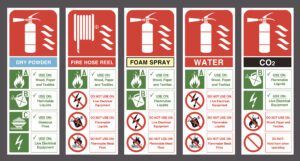
Know the type of fire your fire extinguisher is intended for. Halon variants. Halon, strictly from the point of view of putting out a fire, makes for an almost ideal fire extinguisher. A chlorofluorocarbon, it was effective in smothering all classes of fire, left no residue and was essentially non-toxic. The use of Halon was discontinued several years ago because of its adverse effects on the environment, particularly its role in destroying the earths ozone layer.
Aqueous Foam. This is a relatively new technology for handheld fire extinguishers. Aqueous foam, which coats and clings to both horizontal and vertical surfaces, smothers the fire. It works well on all classes of fire, not spreading Class B fires as does a pressurized plain-water extinguisher. Aqueous foam is apparently a poor enough conductor of electricity to be suitable for use on Class C electrical fires and is extremely effective on Class A fires as well. Clean-up is easy; toxicity appears to be low but is still under study. One caution, though: While you can use an aqueous foam extinguisher on a flaming frying pan (a fire blanket is better), it should not be used when dealing with a large quantity of burning grease or cooking oil or alcohol fires when more than a quart or so of alcohol is involved.
There are a couple of types that you may encounter that are poorly suited for marine use: Carbon Dioxide (CO2) extinguishers. While these work well for Class B and C fires and require no clean-up, the C02 gas dissipates easily, making these extinguishers effective only in enclosed spaces. They don’t cool the fire, so they leave a potential for spontaneous re-ignition.
Water (or soda-acid). While water extinguishers are very good for dealing with Class A fires, they tend to spread burning liquids, making them unsuitable for dealing with a Class B fire. Water conducts electricity, which makes this type hazardous for dealing with electrical fires. Water extinguishers are large, heavy and difficult to store.In Previous Tests…Our most dramatic finding was the limited window of opportunity that each of the dry chemical extinguishers provided to put out a fire. The Kidde UN 1044 sprayed its dust for 13-1/2 seconds; all the others pooped out in 10 to 10-1/2 seconds. Each one managed to extinguish our small fire without a problem, but we’d hate to be at sea facing a fire that wouldnt go out in that short a period. Interestingly, we noted little or no difference in time between a 5-B:C and a 10-B:C extinguisher. Apparently the greater-capacity units simply deliver more dry chemical over the same period of time.
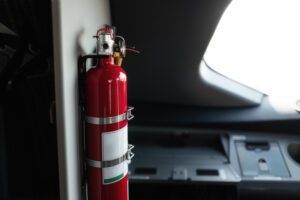
A fire extinguisher in a properly mounted bracket. Another factor that struck us is the dramatic loss of visibility that occurs when you use one of these extinguishers. Our fire became completely obscured by the thick cloud of dust from the extinguishers, and aiming became more a factor of memory than of visibility. The third aspect of using one of these dry-chemical extinguishers is the thick covering of white powder left behind after the fire is out. The Kidde UN 1044’s powder, we found, melted on hot surfaces, making complete clean-up almost impossible; the other three extinguishers used non-melting sodium bicarbonate, which makes clean-up possible, but still extremely difficult and tedious. The First Alert Products had very comfortable ergonomic trigger mechanisms, but the Kidde ones weren’t bad. After all, comfort isn’t a serious requirement for a device that you’re only going to be holding for 10-13 seconds.
Operation of all units was straightforward. You remove the extinguisher from its bracket, pull out or break off a safety tab (red) and squeeze the handles or pull the trigger. Aiming was easy, and all the units were similar in weight, size and balance. The two First Alert models and the Kidde Mariner 10 come with plastic brackets; the Kidde UN 1044 has a steel bracket. We really have a slight preference for metal brackets. The plastic brackets wont rust or corrode; the steel bracket will but is probably a good deal stronger initially.

Know how to operate it All four models tested have commendably easy-to-read instructions on the extinguisher itself. While using an extinguisher isn’t difficult, it’s a good idea to have all crew members review the instructions in a non-emergency setting. Its not something you want to be reading for the first time by firelight. All have gauges that are easy to read. Since gauges can fail, you should test your extinguisher. Weighing the device is an effective alternative to firing its contents. All four models list maximum and minimum weights for fully charged units. Both samples of the Kidde UN 1044 weighed in at slightly under the permissible minimum weight when we received them, although the gauge indicated that they were fully charged.
Also, consult this recall notice before you buy.
TESTING THE NEW UNITS
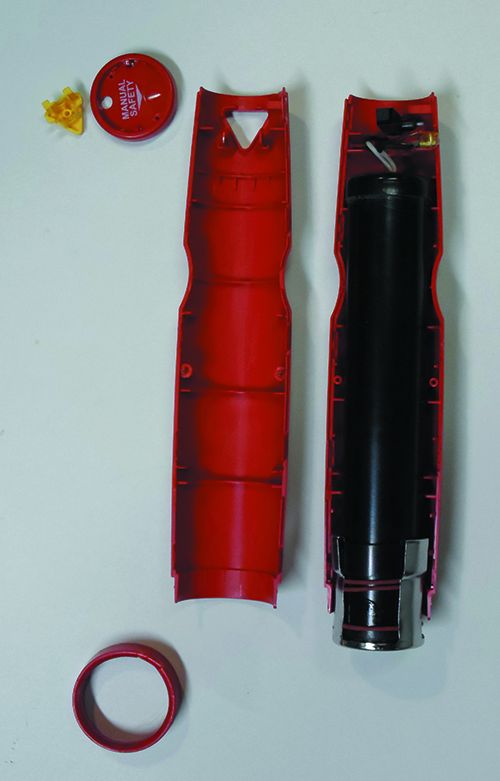
The Maus extinguisher resembles a flare
in a heavy duty plastic housing.We didn’t repeat the standard tests; these units have passed ISO muster with regard to sturdiness and rating. But we did have a few practical questions. To answer them, we built a small fire, limited in size as an incipient fire should be, including wood, fiberglass, gasoline, polyethylene, and PVC. After lighting, we gave it several minutes to get going, waiting until we saw burning fiberglass and dripping plastic. We then put it out with the Maus.
To use point it away from people, pull the safety ring, and press the yellow button. The yellow button activates a piezo lighter, like a barbecue lighter, which ignites the pyrotechnics that power the extinguisher. There was a “pop” as the rubber storage plug discharges from the nozzle and banged into the washtub, followed by a steady hissing and solid stream of extinguishing media for the next 12 seconds. The extinguisher becomes slightly warm, but not excessively so. It has been suggested they you could simple lob it into the engine room and close the door, and that seems reasonable since not even the nozzle becomes hot enough to start a fire, but don’t take that as an endorsement.
The mess is certainly far less than dry chemical, nearly non-existent. However, we noted minor corrosion of solder and brass coupons (in the test tub but away from the flames) that were coated with extinguisher residue and left in a humid jar in condensing condition for five days. The pH of the residue is rather high; 9-11 as measured by dampened pH papers in the test area and the corrosion coupon jar. Concerns have been voiced about long-term corrosion of electronics. We advise that you blow out the area and all equipment using compressed air, taking precautions to avoid breathing the dust (mask with HEPA filters).
The photos don’t do justice to the size and density of the cloud. After finishing our photography, we turned around and noticed that several acres downwind were quite foggy. Inside the cabin of a boat, or even in the cockpit, you can expect zero visibility to persist for some time, depending on ventilation. The fog is light does not settle out.
Unavoidably, we inhaled a small amount, even though we were in the open and upwind. There was slight bite in the air, characteristic of the alkali in the extinguishing media, but it was not choking. Investigators have expressed concern that the very fine nature of the aerosol will cause lung damage—it is much finer than dry chemicals. Pyrotechnically generated aerosol fire suppressants are universally not recommended for confined spaces; there have been fatalities when similar chemistry units discharged into confined spaces. We question claims that the gas is harmless and advise you to exit a confined space fast.
We included burning plastic and fiberglass to see if they would try to reignite. The fire was visibly out within 2-3 seconds, and when the Maus was finished, there was no glow or smoking of the embers.
THE NEW PRODUCTS
Maus Xtin Klein. Remarkable for its diminutive size, this flashlight-sized fire extinguisher (9.4” x 2”) by Swedish company Nordfire packs a lot of extinguishing power into your palm. Roughly equivalent in extinguishing capacity to a much larger 5BC dry chemical extinguisher (CE 13B, which is falls between UL 2BC and UL 5BC), it has a 12-14 second burn time. It has been adopted for wide use in Sweden for first responders and distributed in Europe and Great Britain for a number of years, but expansion into the US has been limited by the lack of a UL rating. Made in China. $79.
Bottom line: Recommended. (Available via www.nordfireinc.com)
Firepal. Basically identical to the Maus Xtin. Distribution in UK only. £70.
Bottom line: Recommended.
Element E50. Also tiny (11.75” x 1.2”), the Element has a less intense but much longer 50-second burn time, with similar extinguishing capacity. This is much longer than a similar sized dry chemical extinguishers, which will be spent in 8-15 seconds. Direct comparison may be misleading, since the you can start and stop a dry chemical extinguisher. Made in Italy. $80.
Bottom line: Recommended. (Available at www.elementfire.com)
CONCLUSIONS
We like the compact size and reduced residue. However, the cloud is incredibly dense, the health effects are not well known, and the lack of a cut-off valve seems like a problem in the confined space of a yacht cabin. Dry chemical is messy and will make you cough, but has proven safe, the dust settles rapidly, and you can cut it off once the fire is out.
Carbon dioxide is a proven clean alternative, but they are bulky, expensive, and CO2 in a confined space can knock you out too. HFC 227 is expensive and hazardous in confined spaces. Bottom line? We’ll carry one of these as a back-up. They really do put fires out, although sheer volume of fumes can be intimidating inside a boat cabin.
WHAT ABOUT AUTOMATIC FIRE SUPPRESSION?
A fire is one of the mariner’s greatest fears. We experienced a fire offshore once. It really gets your blood pumping when you realize there’s nowhere to go and help is a long ways off. That said, automatic fire suppression is intended for those occasions when there is no one around to detect or fight a fire.
When contemplating automatic fire suppression, the first line of defense is meticulous installation following ABYC guidelines. Next is maintenance. Corroded and faulty bilge pump wiring is probably the most common cause of fires in unattended boats. Or perhaps it’s an engine or galley fire.
Even when you are present and capable of fighting the flames, fire extinguishers don’t always work (see the link to the Kidde recall above). They require training to be effective, and often ruin the electronics in the process. They create choking fumes, and because of this, you can’t re-enter the space to mop up embers to prevent reignition. Because of these shortcomings, we’ve reported on fire blankets and other practical firefighting alternatives.
AUTOMATED FIRE EXTINGUISHERS FOR ENGINE ROOMS
Halon systems are an option, often seen in the engine rooms of large motor yachts. They aren’t actually Halon anymore—most are filled with heptafluoropropane, AKA HFC-227 or FM-200. They are expensive ($4,500 and up), require regular inspection, don’t like saltwater, and are not easily adapted to the many small spaces found on a typical sailing yacht. I’ve worked with these in refinery settings, and everything about them feels unsuitable for sailing yachts.MANUFACTURER PROTENG BLAZE CUT MODEL THIA Tube TD Series EXTINGUISHING MEDIA MEDIA HFC-227 HFC-227 ACTIVATION TEMPERATURE 350F 350F PRICE $99 for 2 ft3 to $899 for 75ft3 $145 for 14ft3 to $280 for 55ft3 Tube-based fire suppression systems have simplified automatic fire suppression, making it practical in cars, light planes, and boats. Pressurized tanks, heat sensors and nozzles, are replaced with a proprietary polyamide (nylon) tube filled with the new Halon replacement, fluid FM-200. The tubes are designed to resist compartment temperatures up to 158F for long periods.
If the tube experiences a temperature of 350F anywhere along its length, it ruptures in moments, releasing the entire contents in the direction of the heat source in a fraction of a second. The space must be at least partially enclosed; however, the tube contents are released so rapidly that even if the space is well ventilated, the fire is extinguished before the agent can be dissipated. Ideally, the tube is located within 4 feet of the fire, and often, much closer is practical. By comparison, most single-tank HFC systems, such as the Xintex MA2, discharges at 175F, which is measured at a single point. One advantage of tank systems is a manual activation, handy when a fire is noticed before the heat sensor reacts.
Proteng THIA (tube + heat = instant action) tubes and Blaze Cut TD Series Tubes are warranteed for four years. However, if protected from chafe they are expected to last far longer, up to 10 years. Inspection is a simple matter of visually confirming that the agent is still present (THIA tubes are translucent) or checking a gauge (standard from Blaze Cut, an option from Proteng), and checking for loose clips or chafe.
The tubes are available in a variety of lengths, selected via a calculation to dispense the required amount of extinguishing agent. They must be secured with clips (conduit clips, electrical ties, or other sturdy means) every 10-14 inches. The tubes should be kept away from specific hotspots (turbochargers and exhaust pipes), but they should be located towards the top of the enclosure. Although remote monitoring of the fluid level is possible, it’s often simpler to install the tube where it can be visually inspected.
The list of possible installation locations is long: engine rooms, battery compartments, bilges, electrical panels, and machinery compartments.
Battery compartments present an interesting case. Lead-acid batteries are a piece of cake. Install a few small tubes inside the case and they can snuff a fire out soon as it starts.
Tube-based fire suppression systems are not FM or UL listed because there is no category for the product. If an automatic installation system is required by code a listed fire suppression system must be installed. Of course, in those cases, supplementing with tubes and using the tubes in small areas that are not protected by the main system provides a valuable backup.
Compact and Automated Fire Fighting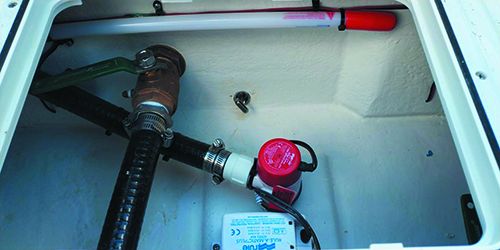
1. Bilge installation. Bilge pump fires are among the more common causes of loss, because corrosion is common and because they run unattended. 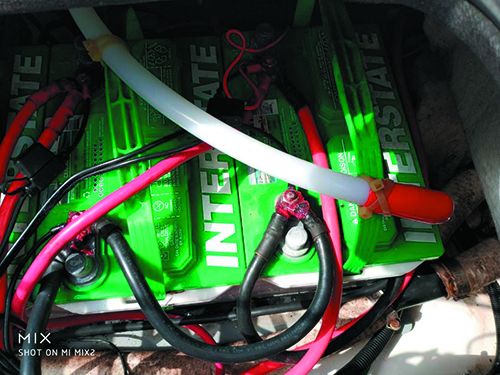
2. Battery compartments present an interesting case. Lead acid batteries are a piece of cake. Install a few small tubes inside the case and they can snuff a fire out soon as it starts. 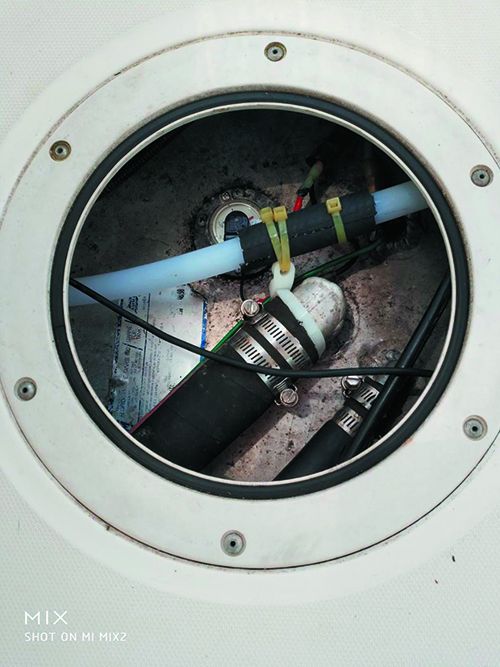
3. Gasoline tanks are logical areas for a tube based fire suppression systems
to be located.
CONCLUSIONS
Perhaps the most concise summary was a comment by a user that “this is technology that isn’t technology.” Installed according to the instructions, the tube will always rupture when it gets hot, instantly filling the compartment with extinguishing agent. Saltwater doesn’t matter. No operator training. No cleanup. What could be simpler?
PS Technical Editor Drew Frye is the author of the book “Rigging Modern Anchors.” You can read his blog at www.saildelmarva.com.









































Interesting and (nearly) thorough report, but you left two questions unanswered, both pertaining to the engine: 1. Does discharge kill a running engine or will the engine simply suck all the extinguishing medium from the engine compartment and blow it out the exhaust? Presumably, if it disrupts the chemical reaction of combustion, it would kill the engine, which means it should only be manually deployed to avoid sudden, unexpected engine shutdown. Does it affect compression ignition (diesel) combustion as well as spark ignition? 2. What effect does the extremely fine particle medium have on engine valves, cylinder rings, etc.? Does it need to be thoroughly vacuumed out of the compartment before restarting the engine?
A 30hp diesel engine will draw about 1 liter per second at idle (4-5 times that much at speed) (gasoline engines draw much less at idle), or an insignificant potion of the extinguishing medium. Yes, it will likely shut the engine down very quickly if enough reaches the air cleaner. Only a few liters of air, media, and smoke will have been ingested. Diesel or gasoline.
An oil change is recommended. The engine compartment should be well vacuumed or blown out with compressed air. However, so far as we know pyrotechnic extinguishers pose very little risk to the internal engine components. The greater risk is to electronics, though it is less than dry chemical extinguishers.
Great article – thank you!
should have mentioned what foam extinguishers work and are available for those Lithium batteries
Interesting, emerging technology – thanks for the update to this important boat safety system. Yes, lithium batteries – we had a boat go up in flames shortly after its owner decided to “upgrade” his wet-chemical type. He reportedly neglected to realign his shore-powered charger to accomodate that different battery type. Appears these PGA-type extinguishers also would have been helpful against the Conception diveboat fire that had 34 fatalities. Investigation reports cited the multitude of assorted lithium devices as a likely contributing fire cause. We’ll review possible PGA suitibility for our 30-boat condo club’s fleet.
The manufacturers specifically commented that these are not effective against lithium battery fires. Many types of extinguishers will knock the flames down, generated by burning plastic and venting gasses, but only massive amount of cooling, typically provided by large volumes of water, will halt the thermal runaway and prevent reignition. Few fire extinguisher manufacturers are willing to say they have an effective product, all include warnings about cooling, and industry testing suggests none are much more effective than water. Salt water can be a problem because it may cause additional sort circuiting.
As for cell phones and other small devices, a quick exit out the hatch is the only sure way.
But we’re looking into it.
Yes a very good article. So what, if any, fire suppression systems are effective against LiFePO4 battery fires? As an electrical engineer who looks forward to moving to Lithium on our 36′ offshore sailboat I have been unwilling to do so due to concerns about fire safety.
Good article; learned about the tube style for the 1st time. Thanks for that. I was a career CG officer in the Marine Safety prgm. Surveyed LNG tankers to MODUs to 3 crew commercial fish vsls and 6 pack operators. As such, I got to investigate a lot of marine casualties and approve/inspect Halon to hold this hose systems. My memories/thoughts/ reflections:
I always thought CG should have made a shift from inspections to instruction. More of a transfer of knowledge, less on enforcement. After all, we work for the public, not the other way around. To wit, I got so frustrated with small fishing boats casualties, that we conducted fire training by building a large bonfire on a Santa Barbara beach and attacked it with various agents. It was amazing what a garden hose capabilities could be shown by just working he base of the fire. Halon was pretty sexy in those days; not so much when we demonstrated a reflash!
When I reviewed systems; I taught builders that our fire concerns could be addressed in 1 of 3 ways. Fire load as well fuel, ventilation and extinguishing capabilities within the compt. Ie, all metal compts with metal furniture don’t burn or fuel systems that could be shut off outside the engineroom; vent dampers with fused links that closed with heat or blowers that could be secured remotely; or a fixed system.
I read this article as I am looking for a new engine room fire extinguisher. There are two tables in the article labeled “AUTOMATED FIRE EXTINGUISHERS FOR ENGINE ROOMS”, but only a few of the extinguishers are actually automated fire extinguishers.
I did some searching and found:
https://proteng.com
https://www.amazon.com/dp/B07KT9JZ6M/ref=cm_sw_em_r_mt_dp_0KBTQDFF9ZN4AWBFFXY2
https://www.elidefireus.com/product-page/mini-elide-fire-marine-ball-4-inches
I found one that is UL certified:
https://www.ul.com/news/nichibou's-erase-tube-fire-extinguishing-device-first-achieve-ul-certification-ul-2166p?linkId=78144140&fbclid=IwAR2B07Drs8eQPeexotQV2i1jHNgmJk7A7Kg1EJR9z0CPg-VcEkew-cYlmEM
but don’t see where to buy it.
I just bought 3 BlazeCut tubes for engine, electrical, and battery areas – about $500 total – cheap extra insurance! Great article as I had no idea such a simple solution existed in addition to a fire blanket and extinguishers.
Great article, did you happen to find anything on the agent PBr3, phosphorus tribromine? I was looking at it several years ago for a different application but it didn’t meet our very specific requirements. Another option for non occupied spaces is a solid propellant gas generator. Same type device used to inflate an airbag can also fill a space such as an engine room with minimal airflow rather quickly and the agent can be non toxic. There are others that actively break up the flame reaction but they had some toxic characteristics. They worked great for us but lost it due to a relight with 20 seconds.
What is the formula to determine tube length for a given engine room volume? I cannot find that anywhere.
Thanks!
Beware Guardian Fire Shield Co of British Columbia. I ordered one of these devices from them, they charged my card and never sent the extinguisher. They don’t return calls or emails.
As a 45 year veteran of the professional fire service, as well as a USCG captain, I have to take issue with some of your points about conventional extinguishers. 1. CO2 extinguishers DO COOL. The gas comes out at minus 109 degrees F, which will cool your hand to the point of frostbite in a nanosecond! They also do not have to be aimed at the source or seat of the fire to be effective in a confined space, as they suppress fire by displacing oxygen. 2. Both ABC and BC dry chemical extinguishers, on the other hand, DO NOT COOL. They DO have to be aimed at the seat of the fire to be effective, and the corrosive damage they cause to electrical and mechanical components often is greater than the damage from the fire. 3. Any fixed extinguishing systems in larger boat engine rooms are gas type systems, either CO2 or HFC-227ea (replacing the older Halon systems). There is a reason for this: Per USCG data, 90% of boat fires start in the engine room. In the enclosed space of an engine room, a gas system is the most reliable and most effective. The standard US Navy fire extinguisher is CO2, for this reason. In my experience, any boat with an inboard engine should use a gas extinguisher system such as CO2 or HFC-227ea, and of the two, CO2 is the more affordable. The only place for a dry chemical system is on an outboard motor fire, where it is out in the open rendering a gas system less effective. In that case, the outboard is probably a write-off anyway, so the additional damage caused by the dry chemical extinguisher is a moot point. I don’t have any experience with the flare-type extinguishers, but based on how they work, I would expect them to be more effective in an enclosed space than out in the open. My concern with them is, as you correctly point out, they are not rated by USCG, ABYC, UL, or NFPA-10, so in US waters they cannot replace other extinguishers. In my own boat (42 ft sailboat with inboard diesel engine) I carry two 5 lb. CO2 extinguishers mounted near the engine room. I also carry several fire blankets, which are inexpensive, have no expiration date, are highly effective for cooking stove & BBQ fires, and like CO2, do not leave any mess or cause any secondary damage. I don’t allow an ABC dry chem extinguisher on board at all. Terry Ney, Assistant Chief, South Whidbey Fire, USCG Master 50 tons.